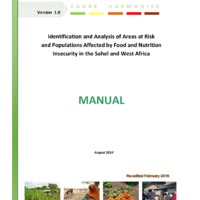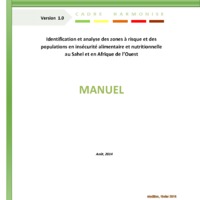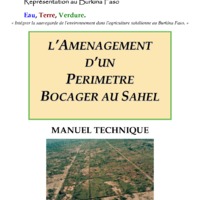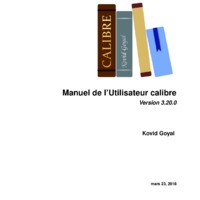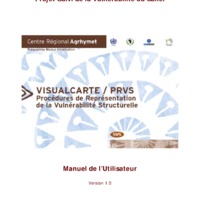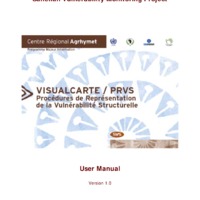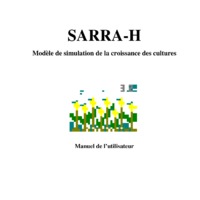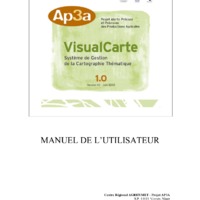Recherche
8 items
Identification and Analysis of Areas at Risk and Populations Affected by Food and Nutrition Insecurity in the Sahel and West Africa
Facing recurrent food and nutrition insecurity affecting Sahelian and West African populations, governments and their development partners have set up mechanisms to monitor food situation. However, these mechanisms do not use the same methodological approaches, which often lead to results that are difficult to compare and which at times are even contradictory. Aware of this situation and the need to find a suitable solution, CILSS member states and partners have initiated the development of a Cadre harmonisé d’identification et d’analyse des zones à risque et des populations en insécurité alimentaire et nutritionnelle au Sahel et en Afrique de l’Ouest (Harmonized Framework for Identification and Analysis of Areas at Risk of and Populations Affected by Food and Nutrition Insecurity in the Sahel and West Africa). This tool, known as “Cadre Harmonisé” (CH), is expected to serve as a framework for countries to assess food and nutrition insecurity on an objective and consensual basis. The purpose of the Cadre Harmonisé is to help countries prevent food crises better and, where appropriate, quickly identify affected populations and appropriate measures to improve their food and nutrition security. The related method has been developed by a group of food and nutrition security experts from CILSS, FAO, WFP, FEWS NET, AFD, IPC/GSU, JRC/EC and UNICEF, and from international NGOs Oxfam International, Save the Children and ACF1. It is worth recalling that starting from 2008, various meetings held by the CH Technical Committee agreed for the CH to include some elements of the Integrated Food Security Phase classification version 1 (IPC 1.0). The IPC is a set of tools and procedures for classifying food and nutrition insecurity severity for decision making. Since the development of a manual for IPC 2.0, discussions have been under way to bring the CH closer to the IPC to incorporate lessons learned that improve comparability of results from the two tools. Similar to the IPC, the Cadre Harmonisé seeks to make best use of a set of tools and procedures for classifying the nature and severity of current and projected food and nutrition insecurity situations on the basis of a consensual analytical framework and classification scale. The CH is based on the following four conceptual models commonly used by national, regional and global mechanisms: Risk = f (Hazard, Vulnerability) Sustainable Livelihoods Framework The UNICEF Nutrition Conceptual Framework The four dimensions of food security (availability, access, utilization, and stability) The CH therefore is an integrated analytical framework built on a technical consensus that seeks to make best use of data from all systems or methods, namely food consumption surveys, nutrition surveys, the Household Economy Approach (HEA) or other information provided by agricultural surveys and market monitoring. The CH assesses food and nutrition insecurity, based on convergence of evidence from several indicators. The CH uses a food insecurity severity scale with five phases. Such a severity scale, which is an international one, makes it possible to make comparisons between countries of the sub-region and also at global level. CILSS was mandated to develop and implement the CH as a common tool for Sahelian and West African countries. Its analysis cycles will from now on help develop regional mapping of current food and nutrition situations and analyze projected situations. 1 Other institutions such as MIFRAC, IBIMET and CARE International initially contributed to the development of the present analytical framework. Cadre Harmonisé MANUAL Version 1.0 Page | 13 The CH also seeks to strengthen the regional integration framework in the CILSS-ECOWAS-UEMOA region so that collaborative and harmonized analyses of food and nutrition situations are conducted through the best possible use of other tools and analysis methods developed by national mechanisms and partners. Given the importance of the process of harmonizing the analytical framework for food and nutrition situations in West Africa, it is necessary that all food and nutrition security stakeholders take ownership of it and make it their decision-making tool. Furthermore, efforts are needed to strengthen the partnership framework within countries and to support the operations of early warning systems in order to improve the collection of reliable data. CH implementation relies on existing data collection mechanisms. Efforts should be made by countries and partners to provide financial support to these mechanisms - as CH implementation will from now on be the baseline reference for activating regional food reserves and mobilizing technical and financial partners (TFPs).
Identification et analyse des zones à risques et des populations en insécurité alimentaire et nutritionnelle au Sahel et en Afrique de l'Ouest
Face à l’insécurité alimentaire et nutritionnelle récurrente qui affecte les populations sahéliennes et ouest-africaines, les Etats et leurs partenaires au développement ont mis en place des dispositifs de suivi de la situation alimentaire. Malheureusement, ces dispositifs n’utilisaient pas les mêmes approches méthodologiques, ce qui a souvent conduit à des résultats difficilement comparables et parfois même contradictoires. Conscients de cette situation et de la nécessité de lui trouver une solution appropriée, le CILSS, les Etats membres et les partenaires ont initié le « Cadre Harmonisé d’identification et d’analyse des zones à risque et des populations en insécurité alimentaire et nutritionnelle au Sahel et en Afrique de l’Ouest».
L’aménagement d’un périmètre bocager au sahel
Depuis 1990, avec l’appui de TERRE VERTE, l’AZN expérimente au sein de sa Ferme Pilote de Guié (FPG) un système d’aménagement des terroirs basé sur la réalisation de périmètres bocagers. A l’instar des périmètres maraîchers protégeant une zone pour cultiver des légumes, l’AZN a développé la technique des périmètres bocagers pour résoudre les problèmes liés à l’agriculture extensive (surpâturage, érosion, feux).
Ces aménagements intègrent des opérations de conservation des eaux et du sol, ainsi que de refertilisation des sols. Les périmètres sont basés sur l’utilisation des haies vives contre la divagation ou l’érosion éolienne et de systèmes de récupération de l’eau.
SARRA-H Modèle de simulation de la croissance des cultures - Manuel de l’utilisateur
SARRA-H est un modèle particulièrement adapté à l'analyse d'impact du climat sur la croissance des céréales sèches et du rendement potentiel en milieu tropical du Mil, Sorgho, Maïs et Riz pluvial.
